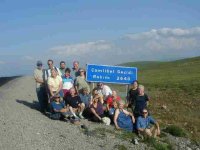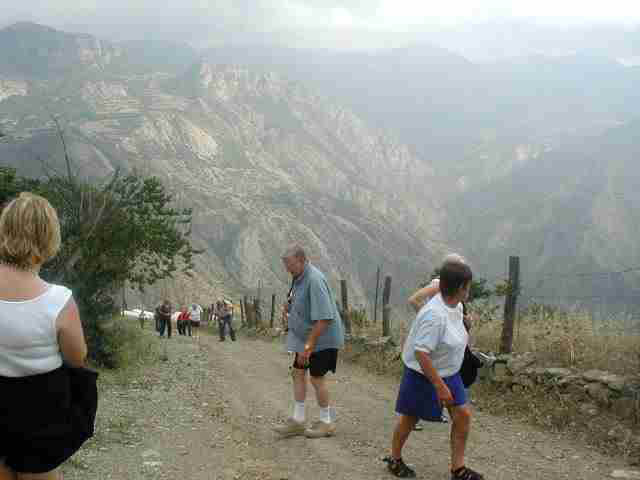|
||||
|
Day
5 Ė Friday, August 3, 2001 Crossing to the Dry Side of the Black SeaRise to the Georgian Border/Artvin and itís surroundingsThe morning finds us hot and steamy from our first totally non-air conditioned night. One of two other tour groups at the Asnur Hotel kept several of us awake last night by dancing, loudly, until midnight. Never-the-less, we are on the road by nine as Meli gives us several interesting news stories: 1. That our dayís itinerary will have to be changed some because the road we are to take inland will be closed part of the day due to blasting for a new hydro-electric dam and 2. That overnight there was a freak storm in Ismir with walnut sized hail.Our first visit of the day is at the Caykur Pazar Cay Fabrikasi (tea factory). We are visiting between crops so things are kind of quiet. When fully operational, this factory will run 24 hours straight and can handle 150 tons of tea leaves per day. Our factory guide informs us that there are five stages in tea production: dehydration, oxidation, fermentation, quality separation and wrapping. The process starts when tea leaves are dumped from trucks unto a conveyor belt which carries them to an upper level room full of screens. Here steam fans blow the leaves until they have reached about 65% of their original moisture content. From here they are ground, squeezed, heated and allowed to ferment and dry further until the desired aroma and color are achieved. The leaf mash then goes through a set of whirling drums which electro-statically suck out impurities and leaf fibers that become animal feed. Finally, the tea is separated into seven qualities that are usually blended to create various medium grades of final product. This will rest for a few months before being shipped. Some interesting facts we learned include: This is one of three privately owned factories. It employs 600 workers and 29 engineers and lab technicians from all over the country during the harvest season and serves 22,000 plantations.All the loose tea produced is consumed in Turkey.Tea in bag form is exported to markets in Germany, Holland and Russia.No chemical additives are used to enhance the color or aroma of Turkish tea.The state provides natural fertilizer and regulates the quantity of tea produced.Tea is good for about 8 months if well covered.Tea bushes live about 50 years and must be pruned to stay healthy and productive.The caffeine content of Turkish tea is 3-4% which is higher than other countries that harvest and produce all 12 months during the year.After leaving the tea factory, we drive a bit further, through several tunnels, to make a brief visit to the Georgian border. On the way back, Meli points out a hole in the mountain next to one of the tunnels. This was a tunnel for camels on the Silk Road.Soon we say farewell to the Black Sea. We begin our speedy trip over the mountains in order to reach the bridge at the town of Borcka before 1:30pm when road will be closed.Cheers go up as Metin makes the trip smoothly with 2 minutes to spare.Everything is dust and construction beyond
|
Borcka.What was once a powerful and beautiful river has been
muddied, scraped and tamed by huge machinery and cascades of blasted
rock falls.In the midst of all of this, we soon see the ancient
fortress of Artvin on a rock outcropping overlooking the steep river
valley. We stop at a restaurant along the river for lunch of shish
kabobs, fries and smooth cool apricot juice: then, on up the road to
drop our bags and catch mini buses at the Hotel Karahan in the city of
Artvin.
|
|||

